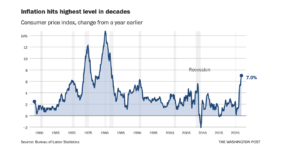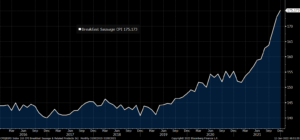Agriculture Secretary Brooke Rollins said on Tuesday that the Trump administration will announce a 'bridge payment' for farmers next week that is designed to provide short-term relief while longer trade…
Food Prices Up 6.3 Percent Since Last Year
Wall Street Journal writer Gwynn Guilford reported in today’s paper that, “U.S. inflation hit its fastest pace in nearly four decades last year as pandemic-related supply and demand imbalances, along with stimulus intended to shore up the economy, pushed prices up at a 7% annual rate.
“The Labor Department said Wednesday the consumer-price index—which measures what consumers pay for goods and services—rose 7% in December from the same month a year earlier, up from 6.8% in November. That was the fastest since 1982 and marked the third straight month in which inflation exceeded 6%.”

More narrowly with respect to food costs, Rachel Siegel and Andrew Van Dam reported in today’s Washington Post that, “The cost of food was up 6.3 percent compared with the year before, as worker shortages and the spread of the coronavirus bedevil grocery supply chains, which has left some shelves empty.”
#Food: 12-month percentage change, Consumer Price Index, December. pic.twitter.com/rTk22kUtmG
— Farm Policy (@FarmPolicy) January 12, 2022
#Food at home: 12-month percentage change, Consumer Price Index, December. pic.twitter.com/8kapQNgnMR
— Farm Policy (@FarmPolicy) January 12, 2022
Also in today’s Washington Post, Abha Bhattarai reported that, “Every category of food — including fruits and vegetables, bread and dairy — has become more expensive in the past year as the industry confronts rising energy and transportation costs, along with mounting labor shortages. The most pronounced increases have been in meat, fish and egg prices, which are up 12.5 percent, in part because of higher grain costs, as well as a shortage of refrigerated trucks and the truckers to drive them. Overall grocery prices have risen 6.5 percent since last year.”
Inflation hit 7% in December. Here are key price hikes:
— Heather Long (@byHeatherLong) January 12, 2022
Gas 49.6%
Fuel oil 41
Used cars 37
Rental cars 36
Hotels 27.6
Utility gas 24
Steak 21.4
Beef 18.6
Bacon 18.6
Furniture 13.8
Tires 12.4
New cars 12
Eggs 11
Suits 11
Chicken 10
Fish 10
Ham 10
Restaurants 6.6
Rent (OER) 3.8
Bloomberg writer Alexandre Tanzi reported on Wednesday that, “Food costs, which account for about 14% of the consumer price index, jumped 6% in December from a year earlier, led by meats such as bacon — up almost 19%.”
Also on Wednesday, Financial Times writers Colby Smith and James Politi reported that, “Food prices also contributed once again to the historically high figures. Dining out costs rose 0.6 per cent from a month ago, a 6 per cent year-on-year increase and the largest rise since January 1982.”

Meanwhile, Reuters writer Tom Polansek reported this week that, “Rising COVID-19 infections among U.S. workers have forced meat plants to slow production and the government to replace slaughterhouse inspectors, meat companies and union officials said.”
Polansek explained that, “Less slaughter capacity reduces U.S. beef supplies at a time of booming demand and means farmers must keep cattle longer in feed yards or on ranches. A sustained period of lower production could further increase high meat prices at a time of inflation fears.”





